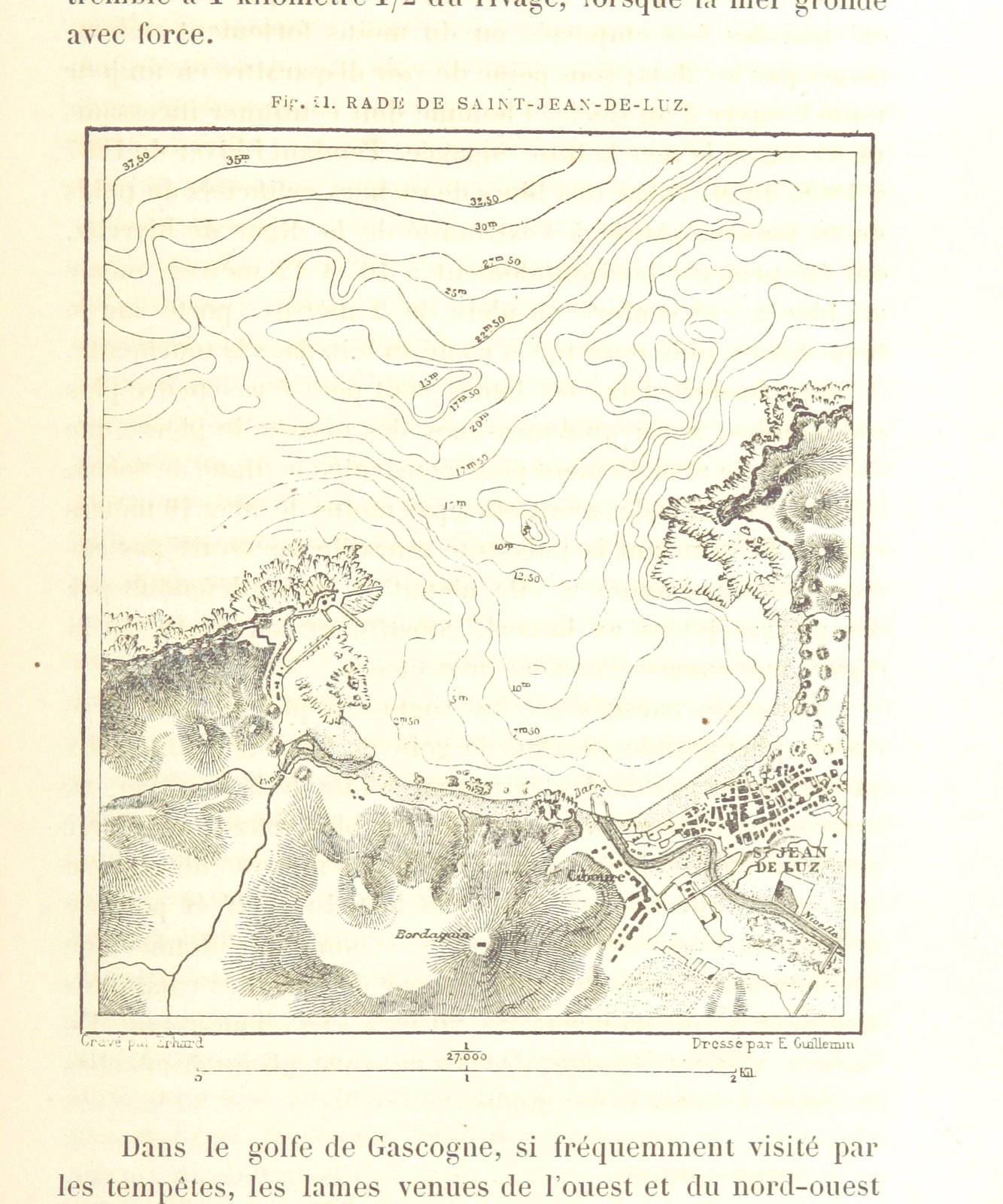Fierce seas have lifted a 50-tonne concrete block and dumped it on the breakwater
at Atlantic french resort St-Jean-de-Luz.

The block, spotted on top of the centre Artha breakwater, was thrown up by waves earlier this week during the violent storms ('Ekaitz' in Bask language) that lashed the length of the Atlantic coast.
- above photos Dominique Reis -
photo Paco Elissalde
at Atlantic french resort St-Jean-de-Luz.

The block, spotted on top of the centre Artha breakwater, was thrown up by waves earlier this week during the violent storms ('Ekaitz' in Bask language) that lashed the length of the Atlantic coast.
- above photos Dominique Reis -
photo Paco Elissalde
An ocean wave "casually" lifted a 50 ton block of
concrete onto one of Saint Jean de Luz town's piers (digue de l'Artha) during Feb 28th's storm
photo : Mathieu Mengaillou / Komcébo
Image taken from page 103 of 'La Terre: description des phénomènes de la vie du globe. I. Les Continents. II. L'Ocean, l'Atmosphere, la Vie' -1868-
Saint Jean de Luz bay, scanned marine map (#3647), published in 1878
Survey from 1876 by M. A. Bouquet De La Grye, hydrograph, assisted by M. Favé, student engineer.
-courtesy of SHOM old maps-
Note : the Artha dike was not completely built at that time.
extract from 'Plan de la Baie de St Jean de Luz' (Artha massif)
Survey in 1873 by Mr A. Bouquet de la Grye
full plan on BNF/Gallica
St- Jean -de- Luz plan, with the different building projects for the bay, by Thouars & Dupuis, 178x
map on BNF/Gallica
In 1857, Napoleon III approved the construction of three dikes (Sokoa, Artha and Sainte Barbe), which began in 1863.
15 years and 7,400 blocks of 50 tons were needed to raise up the Artha massif (see pictures above), located at depths varying from 6 to 14 m and then again 10 years to build a 250 m long masonry of 32,000 cubic meters.
The final work was completed only in 1895, so more than 30 years after with the Sainte Barbe dike.
(see above)
Saint Jean de Luz bay with the GeoGarage platform (SHOM chart)
Pleiades image CNES 2012
Saint-Jean-de-Luz and its characteristic seashell-shaped bay
-photo taken by Thomas Pesquet, ISS on January 1st, 2017- credit : ESA/NASA
Saint Jean de Luz/Ciboure bay in winter
video : Gaël Duval

photo : Mathieu Mengaillou / Komcébo
Image taken from page 103 of 'La Terre: description des phénomènes de la vie du globe. I. Les Continents. II. L'Ocean, l'Atmosphere, la Vie' -1868-
Survey from 1876 by M. A. Bouquet De La Grye, hydrograph, assisted by M. Favé, student engineer.
-courtesy of SHOM old maps-
Note : the Artha dike was not completely built at that time.
extract from 'Plan de la Baie de St Jean de Luz' (Artha massif)
Survey in 1873 by Mr A. Bouquet de la Grye
full plan on BNF/Gallica
St- Jean -de- Luz plan, with the different building projects for the bay, by Thouars & Dupuis, 178x
map on BNF/Gallica
In 1857, Napoleon III approved the construction of three dikes (Sokoa, Artha and Sainte Barbe), which began in 1863.
15 years and 7,400 blocks of 50 tons were needed to raise up the Artha massif (see pictures above), located at depths varying from 6 to 14 m and then again 10 years to build a 250 m long masonry of 32,000 cubic meters.
The final work was completed only in 1895, so more than 30 years after with the Sainte Barbe dike.
(see above)
Saint Jean de Luz bay with the GeoGarage platform (SHOM chart)
Pleiades image CNES 2012
Saint-Jean-de-Luz and its characteristic seashell-shaped bay
-photo taken by Thomas Pesquet, ISS on January 1st, 2017- credit : ESA/NASA
video : Gaël Duval

Measuring the same size as a small car – the block was thrown about 20m by the waves which came as orange alerts for ‘vagues-submersion’ were in force,
The storm waves plus a strong north-westerly current combined to lift the block.
The storm waves plus a strong north-westerly current combined to lift the block.
A concrete block of 4 meters long, about 2.5 meters wide and 2 meters thick (20 m3),
so a weight of 50 tons !
This phenomenon has already occurred during the storm of December 27/28/29th, 1951 and has not since been renewed : a concrete block was also thrown on to the breakwater – and then washed it off a few days later.
so a weight of 50 tons !
Links :
- Sud-Ouest : Baie de Saint-Jean-de-Luz : un bloc de 50 tonnes déposé sur la digue de l’Artha par l’océan / Un cadeau de l'océan
- Alain Miranda diaporama
- YouTube : Inspection of the Artha breakwater
- Histoire de la Baie de Saint-Jean-de-Luz Ciboure (book of Guy Lalanne)
- BNF/Gallica Saint Jean de Luz maps : XVIIth century / ? / 1614 / 1749 / 1872
- BRGM : Etude de l'érosion de la Côte Basuqe, synthése bibliographique
- GeoGarage blog : Image of the week : the Basque Country corniche













Sud-Ouest : best pictures of the 50 tons block
ReplyDeleteFrance 3 TV video
ReplyDelete